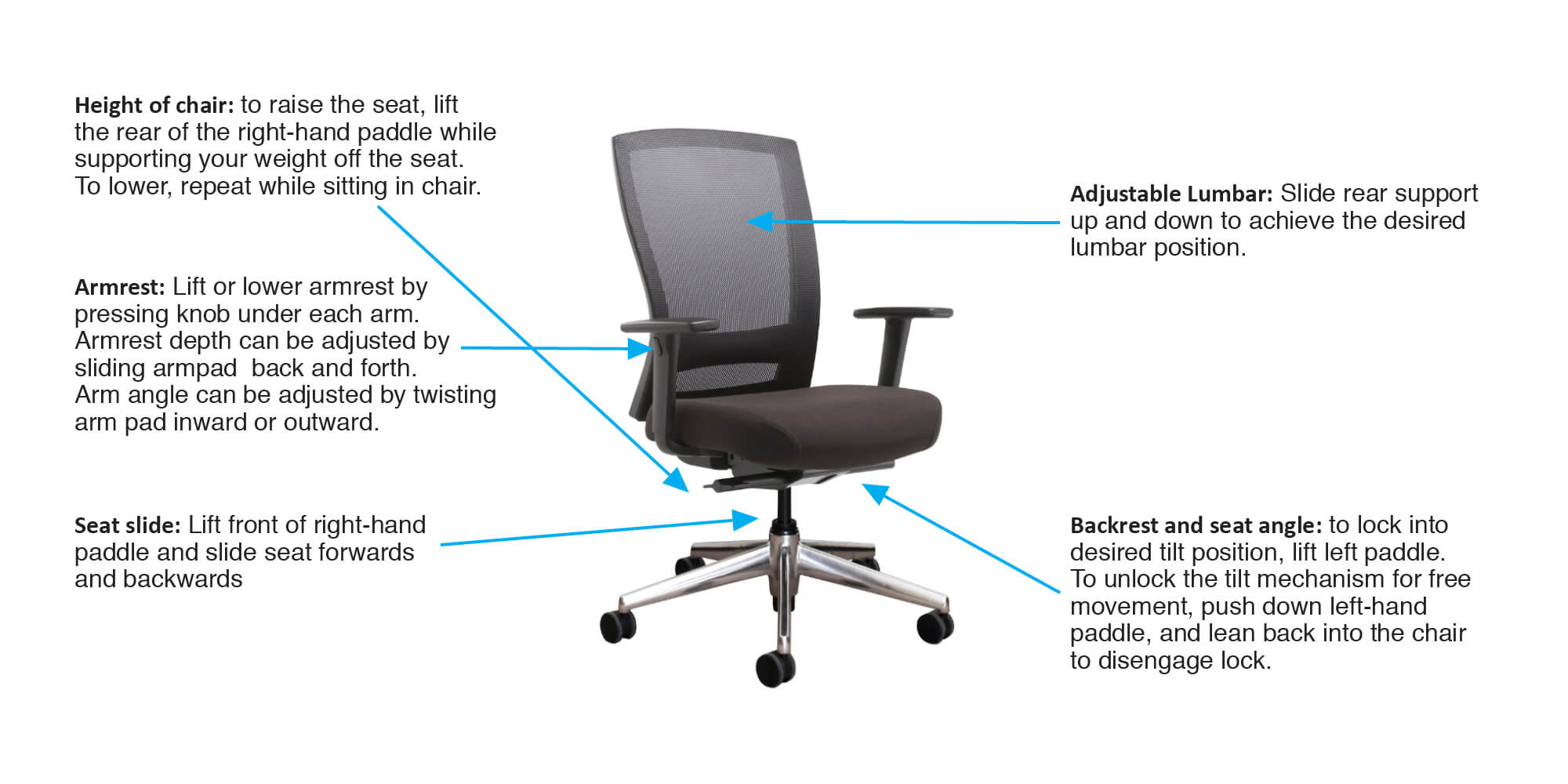Resources
Synchro Mechanism Chairs
Synchro Mechanism Chairs or “synchronous” chairs are a more recent development in chair ergonomics. Synchro Mechanism Chairs have a tilt mechanism that moves both the seat back and seat together automatically for optimum support.
The benefits of synchro mechanisms:
- The chairs are dynamic and move with you, allowing you to maintain full contact with the backrest regardless of your movement – the backrest moves forward with you whilst you are working at the desk, but moves backward with you if you recline to talk on the phone.
- It also allows your body muscles to move more throughout the day
- A great option for agile, open plan workplaces where staff use different hotdesks and chairs each day – the chair requires minimal adjustment by the user and enables the user to achieve close-to optimum posture each time.
Some Synchro Mechanism Chairs have a lever to lock or unlock the synchro action, and a synchro tension adjustment that allows you to adjust the amount of tension required to suit your body weight.
Other synchro mechs are purely weight-activated and adjust the synchro tension automatically dependent upon your weight.
Below is a guide to getting the best out of your Synchro mechanism chair. Note that not all synchro mech chairs are the same, and the position and operation of the levers may vary. This guide is based on the Buro Mentor chair.
Subscribe for free resources and news updates.
To adjust a synchro mech chair:
Note: these notes are general, not all synchro chairs are the same. Diagram above is for Buro Mentor chair.
Sit on chair with your bottom up against the back of the seat.
1. Height of the chair. Adjust the height of the chair by pulling on the seat height lever. This lever is often marked with an up and down arrow and is on the right-hand side of the chair.
To increase the seat height lift your weight from the seat and lift the lever. Release at preferred height
To decrease the seat height use your body weight while sitting in the chair and lift the lever at the same time. Release lever at desired position.
Aim: Your feet should be flat on the floor and legs at right angles. Ideally your arms should be at right angles to the desk top. If you are unable to place your feet firmly on the floor, you may need a footrest.
2. Angle of backrest and seat. The angles of the seat and backrest will move together as you move unless you lock it into the desire position.
To lock the mechanism into the desired tilt position, lift-up the left-hand paddle, find desired position and release.
To unlock this mechanism for free movement, push the left lever down and lean back into the chair to release the lock. Release lever.
3. Tension control. If you chair has this feature, you’re able to determine the amount the chair moves with you, depending on your body weight.
To increase tension Turn the tension control clockwise to increase backrest pressure
And reduce responsiveness of the chair
To decrease tension Turn the tension control anti-clockwise to release the tension and increase the responsiveness of the chair.
4. Seat Slide. Not a standard feature on all chairs. If present, the lever is usually positioned to the front left-hand or right-hand side.
To Adjust: Pull lever/knob, plant your feet firmly on floor and shift your weight to slide the seat horizontally, forward or back to suit your leg length.
Ideally you should have a hand’s width between the front of the seat and the back of your legs when seated and feet positioned firmly on the floor.
5. Height of chair back. Not all synchro mech chairs have adjustable backrests. If so, it is likely to have one of two mechanisms to adjust the back height, a ratchet back, or a non-ratchet back.
To adjust a ratchet back: lift the seat back with both hands on either side of the back as it clicks in increments (usually 6-8 clicks), until you find your desired seat height. Once it reaches the highest point, the seat resets to the lowest position.
To adjust a non-ratchet back: there will be a knob or lever at the bottom rear of the backrest. Loosen this knob to allow the back rest to be adjusted, lift or lower back and tighten once the desired height is achieved.
Many chairs have a protruding lumbar support built into the back of the chair. This should ideally be positioned in the curve of your lower back.
6. Lumbar support. Some chairs with built-in lumbar support allow the level of support to be adjusted, either via a pump or dial that increases the level of protrusion of the lumbar, or a sliding mechanism to adjust the position.
Adjust this so that the curve of your lower back is in contact with the back of the chair. This can help relieve lower back pain.
7. Armrest height. If your chair has arms, they are best positioned so they fit under the desk. Arms can be adjusted to raise up and down, slide forward and back or twist for angle adjustment.
Otherwise you will be leaning forward, or sitting too far forward in your chair to reach the desk.


